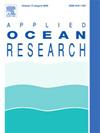Development of Spatial Clustering Method and Probabilistic Prediction Model for Maritime Accidents
IF 4.3
2区 工程技术
Q1 ENGINEERING, OCEAN
引用次数: 0
Abstract
Maritime accidents are complex incidents characterized by the absence of physically defined routes, unlike roads, and influenced by various factors such as marine conditions, vessel status, and multiple contributing factors. Despite efforts to reduce maritime accidents in Republic of Korea, the number of accident occurrences remains at a high level. Moreover, the infrequency of severe accidents makes it difficult to gather sufficient data for comprehensive analysis. This study aims to construct and validate a maritime accident prediction model to protect life and property in the event of accidents, considering the characteristics of the ocean, where tracking and managing transportation means is challenging. For the first step of predicting maritime accidents, a 5-level spatial system was constructed based on the density of accidents and vessel traffic. The data to be used in the analysis was constructed through four steps. In order to evaluate the maritime accident prediction model, we conducted a comparative analysis with the machine learning-based ANN model using a Confusion matrix. Cost-of-omission analyses were conducted based on vessel traffic volume and environmental factors according to the seasons to examine the influence of variables on the probability of maritime accidents. Based on this, implications are presented through an analysis of the causes of maritime accidents according to their factors.
海上事故空间聚类方法和概率预测模型的开发
海上事故是一种复杂的事故,其特点是与道路不同,没有实际确定的路线,并受到海洋条件、船舶状态和多种诱因等各种因素的影响。尽管大韩民国努力减少海上事故,但事故发生的数量仍然居高不下。此外,由于严重事故的发生频率较低,因此很难收集到足够的数据进行综合分析。本研究旨在构建和验证一个海上事故预测模型,以便在发生事故时保护生命和财产安全,同时考虑到海洋的特点,因为在海洋中跟踪和管理运输工具具有挑战性。在预测海上事故的第一步,研究人员根据事故密度和船舶流量构建了一个五级空间系统。用于分析的数据通过四个步骤构建。为了评估海上事故预测模型,我们使用混淆矩阵与基于机器学习的 ANN 模型进行了比较分析。我们根据船舶交通量和季节环境因素进行了排放成本分析,以研究变量对海上事故发生概率的影响。在此基础上,根据海上事故的因素分析了事故原因,并提出了相应的影响。
本文章由计算机程序翻译,如有差异,请以英文原文为准。
求助全文
约1分钟内获得全文
求助全文
来源期刊

Applied Ocean Research
地学-工程:大洋
CiteScore
8.70
自引率
7.00%
发文量
316
审稿时长
59 days
期刊介绍:
The aim of Applied Ocean Research is to encourage the submission of papers that advance the state of knowledge in a range of topics relevant to ocean engineering.
 求助内容:
求助内容: 应助结果提醒方式:
应助结果提醒方式:


